Building an ontology by transforming complex triples
a triplet and complex technology, applied in the field of knowledge management data processing methods and systems, can solve problems such as other mismatches
- Summary
- Abstract
- Description
- Claims
- Application Information
AI Technical Summary
Benefits of technology
Problems solved by technology
Method used
Image
Examples
example 1
[0147]becomes:[0148][0149]
example 2
[0150]becomes:[0151]
example 3
[0152]becomes:[0153]
[0154]The syntactic transformation rules specified in the process of FIGS. 4A-4F and the additional rules described above do not constitute an exhaustive list. Regardless of the particular list of syntactic transformation rules, the syntactic transformation performed in step 304 (see FIG. 3) must ensure that the complex triples are compliant with grammar 112 (see FIG. 1), and that the category and role of every term in the complex triples are identified. The semantic transformation (i.e., step 306 in FIG. 3) applies transformation rules that are different from the transformation rules described above relative to FIGS. 4A-4F, and the transformation rules applied by the semantic transformation may depend upon the category and role of the term to be transformed.
[0155]In one embodiment, grammar 112 (see FIG. 1) used in the process of FIGS. 4A-4F is a well-defined grammar that specifies: (1) a compound subject as including noun(s) and zero or more adjectives; (2) a co...
PUM
 Login to View More
Login to View More Abstract
Description
Claims
Application Information
 Login to View More
Login to View More - R&D
- Intellectual Property
- Life Sciences
- Materials
- Tech Scout
- Unparalleled Data Quality
- Higher Quality Content
- 60% Fewer Hallucinations
Browse by: Latest US Patents, China's latest patents, Technical Efficacy Thesaurus, Application Domain, Technology Topic, Popular Technical Reports.
© 2025 PatSnap. All rights reserved.Legal|Privacy policy|Modern Slavery Act Transparency Statement|Sitemap|About US| Contact US: help@patsnap.com



